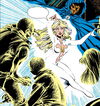Template:TOCleft
Levitation
[top] [Edit Levitation]
Life Essence
(See Also: Astral Form and Death)
[top] [Edit Life Essence]
Lift
Lightforce
Lightforce is the name given to a force of energy that is the counterpart to the Darkforce, its opposite in every way. While the Darkforce is corruptive, Lightforce energy is cleansing, being derived from life force and capable of purging toxins, drugs, and other malignant substances, as well as curing diseases, mental instability, and criminal inhibitions.[1] It can also be used offensively, as seen with Tandy Bowen's signature light daggers.
Overuse of Lightforce-related healing powers weakens the user, potentially leaving them vulnerable to attack. Lightforce users are also vulnerable to Darkforce energy, which can disable them.[2] Darkforce users can also feed off Lightforce energy, as seen with the symbiotic relationship between Cloak and Dagger.
Lightforce users affected by Mister Negative's corruptive touch - derived from the Darkforce - will become Darkforce users themselves, and vice versa.[3]
Known Users of Lightforce
- Dagger
- Cloak (When inverted by Mister Negative)
- Mister Negative (Martin Li)
- Anti-Venom Symbiote (The result of remnants of the Venom symbiote being infused with Martin Li's Lightforce power and merging with its host's leukocytes)
- Lord of Light
Links
- Appearances of the Lightforce
- Minor Appearances of the Lightforce
- Mentions of the Lightforce
- Images of the Lightforce
[top] [Edit Lightforce]
Limbo
[top] [Edit Limbo]
Limbo (True)
[top] [Edit Limbo (True)]
Limited Series
The limited series is a term referring to a comic book series with a set finite number of issues. A limited series differs from an ongoing series in that the number of intended issues is determined before production of the series, and differs from a one-shot in that it is comprised of multiple issues. It is still different from a finite series in that the number of issues is pre-determined while the latter has no definite number of issues set which could run for a number of years before it ends.
The term is often used interchangeably with "miniseries (mini-series)" and "maxiseries (maxi-series)", often depending on the length and number of issues. In Dark Horse Comics’ definition of a limited series, "This term primarily applies to a connected series of individual comic books. A limited series refers to a comic book series with a clear beginning, middle and end. Limited series may also be referred to as mini-series (less than twelve individual issues) or maxi-series (twelve or more individual issues)." [1] DC Comics refers to limited series of two to eight issues long as miniseries while nine to twelve issues or longer as maxiseries while Marvel Comics originated the term limited series itself. Other publishers alternate terms calling such works as either limited series or miniseries while others still choose not to label at all.
Characteristics
The limited series has a single specific story to tell. They follow the standard plot set up of beginning, middle and resolution. Usually, all plot points are covered by the end of the series. There have been limited series done in an anthology format but there have been only a few of these produced.
Limited series are often done by a single creative team but in cases where there are changes, it is usually the writer who remains constant throughout the run while the artist may change hands. The number of issues is usually determined by the writer’s plotting and also by editorial mandate.
History
The genesis of the limited series may be traced to anthology series and back up stories in series featuring the title character. Publishers would often experiment with new characters and stories. If proven popular, these characters were quickly spun off to their own titles. This was particular of comics during the 1960s and through the 1970s which saw a boom in sales of comics. This was often done despite uncertainty whether a character or team could carry on a series more than a few issues.
Nowhere is this more seen than in DC Comics which continuously released a slew of titles between 1975 and 1978, reaching close to 60 monthly ongoing titles. Eventually, DC was forced to scale back and cancel more than one half of its titles (see the so-called DC Implosion). Aside from suffering financially, DC Comics was also criticized for straining itself creatively and editorially, affecting the quality of their comics.
After recovering from the implosion of its titles, DC Comics decided to experiment with a new format to tell stories. The result was the 1979 World of Krypton miniseries, as DC Comics calls such short run works. The new format allowed them to tell stories that may not fit in to an ongoing series and to showcase characters into a short story without the risk and obligations of an ongoing monthly. It also freed creators to tell a longer story without the confines characteristic of a backup story.
With the success of the miniseries format, DC Comics followed by experimenting with longer stories and concepts that are outside of their universe of superheroes. First began in 1982, Camelot 3000 was the first limited series to run to twelve issues and be dubbed as a maxiseries.[2] It was printed on Baxter paper stock and sold through direct market stores. DC Comics followed it with another important contribution to the concept with a new book format. Ronin was printed on glossy paper stock and introduced the Prestige Format. The Prestige Format (or bookshelf format as called by other publishers) is packaged within a cardstock cover and square bound with more pages than the conventional magazine pamphlet and no advertisements. [3] Without the advertisements, it resulted in a different pacing in comic storytelling. The Prestige Format is not favored by other publishers and DC Comics is the only one that almost exclusively continues to use it.[citation needed]
It did not take long for other publishers to follow the limited series form. Marvel Comics used it to feature popular characters from team titles and put them in a lengthy solo adventure. Wolverine's earliest solo adventures were told in limited series. Crossovers between two characters or teams presented as major storylines were also in limited series form before the concept of crossover stories jumping from one title to another was conceived. Contest of Champions brought forth the idea of a major event affecting the Marvel Universe, this would be taken further with the twelve-issue Secret Wars saga in 1984 and by DC Comics’ Crisis on Infinite Earths in 1985.[citation needed]
Majority of Dark Horse’s comics are released in limited series form. Their contribution would be the idea of a series of limited series. Each limited series told a complete story to be followed by another one that builds its story from the previous one. This provided an avenue for creator-owned works where the uncertainty of investing the creator’s property in an ongoing series is lifted from the creator’s concern. The owning creator could complete a limited series installment and follow it with another when they can. This is a model other publishers would use.[citation needed]
Since then, the limited series made it possible for creators to tell graphic novel length stories. Releasing the story in monthly installments enabled them to immediately receive returns on investment. Further returns are possible with trade paperback collections of the series.[citation needed]
Length of Limited Series
Four to six issues is still the norm for most limited series and presents as the most reasonable investment for comic publishers though there are series that run for as short as two or three issues. Twelve-issue maxiseries form was popular in the 1980s. Many memorable series ran in this length such as Secret Wars, Crisis on Infinite Earths, Watchmen, and Squadron Supreme. This form almost faded out in the 1990s. One point that went against it was the greater financial risk in investing in a lengthy limited series. The popularity of the maxiseries length was resurrected by DC Comics with the success of Batman: The Long Halloween and followed by The Kents.[citation needed]
Stories of greater length, those running to more than twelve chapters, were often done in multi-title crossovers, though the 1995 Marvel Comics event, Age of Apocalypse, involved several limited series that replaced the ongoing X-Men related titles for four months and bookended by two one-shot specials. This idea was revisited by Grant Morrison in 2005 with the Seven Soldiers of Victory project which he dubbed a “mega-series”. [4] Marking the difference between the two, Age of Apocalypse was produced by several writers while Seven Soldiers was "the most ambitious undertaking so far by a single writer".[citation needed]
As a rule, the number of issues a limited series will run is determined from the outset. However, there are cases where this rule is changed. Two reasons stands for this, one is often commercial while the second is, to a rarer extent, creative. Dark Horse’s 1993 Aliens: Colonial Marines was originally to have a run of twelve issues. When the sales of Colonial Marines faltered midway through the run, the series was shortened to ten issues. Marvel’s Big Town Vol 1 was set to run six issues only to be set back to four issues. Number changing does not always result in reduction of issues. The first Gen¹³ was to run four issues with the fourth a double-sized finale. Instead, the final issue was split to two in order to meet publishing schedule. Brian Michael Bendis found difficulty in resolving the finale of Ultimate Six and Marvel granted his request of extending the series from six to seven issues.[citation needed]
(See Also: Sequential Tart interview with Jenette Kahn, List of Limited Series)
[top] [Edit Limited Series]
Glossary:Lycanthropy

